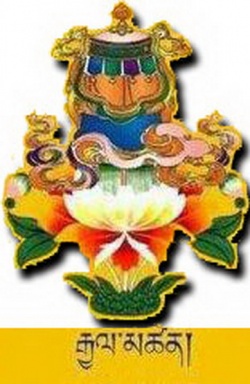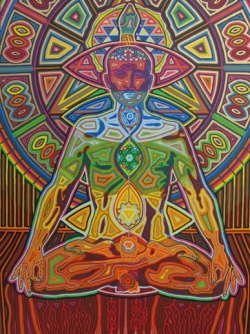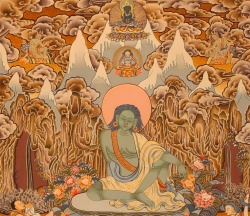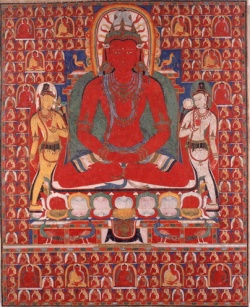Praying to the Lama
by Lama Gendun Rinpoche
The lama is the one who has inherited the realisation of the Dharmakaya Dorje Chang, handed down through an unbroken lineage without there being the slightest damage, the slightest break in this transmission. This means that when we pray to the lama, we are praying to enlightened mind. The lama incarnates the enlightened compassion that holds the blessing, he is therefore truely capable of transmitting this blessing of compassion and Dharmakaya. The lama has the ability to transfer all his qualities to the disciple, but whether we can actually develop these qualities ourselves will depend on the confidence we have and the prayers we address to him.
When we pray to the mind of the lama, we are not praying to the mind of an ordinary person. The lama is not what he seems to be; he is the fundamental mind, the mind of compassion, the Dharmakaya Dorje Chang, and this is where our prayers are directed. Since the lama is the holder of the blessing of the Dharmakaya, he is the pivotal access point, which is why we speak of the lama as being a gateway: the one who opens the door to blessing and the transmission that goes with it. By praying to the lama, this door is opened. To understand the lama in this way means that we don’t consider him as a mere person. Praying to the ordinary mind of a flesh-and-blood person will only bring the realisation of that ordinary state, which is not our aim. On the contrary, in our prayers to the lama, we must think of him as the embodiment of all the Buddhas, the mind of compassion and wisdom of all the Buddhas. If we pray to the lama on that level, then that will be the result we will obtain, thanks to his blessing
It is just like when we have a Buddha statue or a Dharma book. It is a medium. If in front of this medium we think that we are really in the presence of the Buddha’s body or speech, then we actually receive the blessing of the Buddha and his teaching through our respectful attitude. If we consider the medium to be the presence of the Buddha, we receive the blessing of the Buddha – it all depends on our state of mind. With the lama, it is the same – he represents a medium that can bring blessing.
When we pray to the teacher, it is obvious that we should not address ourselves to the person as such, but to the enlightened mind which flows through him or her. If we pray to the person, there will be limitations, we will see before us a human form with its capacities or lack of them. In the relationship between teacher and disciple, we use the presence of the person to make contact with enlightened mind. It is through such a medium or support that we will receive the blessings that will enable us to clear away our veils. This is why it could be said that the ability of the disciple to see beyond the outer form of the teacher is perhaps more important than any abilities the teacher might have.
A well-known example illustrates this, the story of the old Tibetan woman whose merchant son made a trip to India and who asked him to bring her back from India some holy relics, anything that had been touched directly or indirectly by the Buddha. The son left on his travels, but like all merchants, he was so busy that it was only when he was within sight again of his mother’s house that he realised he had forgotten to bring his mother something back from his trip to India. He was wondering what he could do when, within a few steps of the house, he saw the dried-up skull of a dead dog. Pulling out one of its teeth, he wrapped it in a piece of fine silk and presented it to his mother as one of the Buddha’s teeth. His mother did not doubt this and placed it on her shrine. She spent the last years of her life using this “tooth of the Buddha” as a support for her devotions, practising and making offerings before it. Through this support, actually a dog’s tooth, she received the blessing of the “Buddha’s tooth”, the blessings of the enlightened mind, so that at her death she displayed all the signs of realisation and left relics in her cremation fire.
When we pray to the lama, we should think that at that moment he is the embodiment of all lamas. We are not praying to this lama now, and then later to another one, that this one we like but the other one not so much – such an attitude is wrong. We must simply develop a very profound and strong confidence that all lamas are one. They are just different aspects, different manifestations of the same essence.
We should pray in the awareness that our feeling of the presence of the lama includes within it all the lamas we have ever known, from all lineages. We shouldn’t get involved in attitudes of mind which lead us to think, “I will pray to this lama, but not that one because he is not my lama”. All such attitudes, because they are dividing up reality itself, are wrong. When we pray to the lama, we are not praying with the intellect, in a conceptual way, calling on one lama while we tell the others to stay where they are. There has to be a dimension of wisdom: the lama himself represents this primordial awareness which is omnipresent, and therefore can be found in all lamas.
Everything emanates from the root teacher, all is included in him – all the yidams are projections of the lama, all the Buddhas are included in the lama. If we pray to the very source, we pray to everything at once. If we reject one lama, then we reject all the Buddhas, because there is not a single Buddha who has not needed a teacher to reach enlightenment. Since the potential to realise Buddhahood depends solely on the lama, rejecting the lama is equal to rejecting all the Buddhas. That is why we should pray to the lama while thinking that he is completely inseparable from all Buddhas, all teachers, until our mind becomes inseparable from his.
Since when we pray to the lama we are not addressing ourselves to the physical person as such, we can very well pray to the lama without giving him any form, any appearance at all, without giving ourselves any specific reference point. In that case, we simply consider the lama as a representation of the blessings of the compassionate mind of all the Buddhas. With this state of mind we open ourselves to this blessing, allowing it to enter us. We should develop a deep confidence in the capacity to have this blessing really transferred to us, along with all the qualities of the lama which are also those of all the Buddhas. In this way, if we develop sufficient confidence, we don’t have to give the lama a formal aspect, we don’t have to think of anything else, we don’t even feel the need to address ourselves to the lama as a person: through the lama, we are addressing ourselves directly to the transmission, to this aspect of compassion and blessing that is the enlightenment of the Buddhas. So it is not necessary to see the lama with our eyes or use our mouth to speak to him. The important thing is to pray to the lama with trust and conviction. It is useless to recite a prayer without having confidence.
If we do a lama practice without having confidence, we may indeed have a lovely vision of the lama, representing him very clearly in our mind, but that is not what the practice really involves – we’ve missed the point. We can also think of the lama in his physical form and pray to him like that, thinking of him as such and such a person, but that is like having an ordinary relationship with someone. If the lama is old or ugly, we will feel distaste, while if he is young and good-looking, we will feel attracted to him, and once again we will be mistaken in our practice.
The right attitude towards the lama is one of confidence in what he represents and in the blessing that he bears. The strength of the confidence and devotion that we develop in the lama has the effect of making the lama melt into light, whatever the image we have had of him, however we have represented him. This light then mixes with us, and we think that in this way we receive the true blessing of the lama and everything it represents. Otherwise, we always have an attitude towards the lama which is based on our own desires, our own aspirations, our own wilfulness, which we then project onto the lama in the hope that he will respond to our desires. Everything that arises in us at that point, all our aspirations, are nothing other than desire and the wish to have it confirmed by the lama. The end result of this kind of practice, this sort of praying, is only to develop more desire, and we grow more and more dependent on desire.
If we do the guru yoga properly, through prayer, the lama and our own mind will mingle and become united, completely one. We will settle into a state of union which is the real meaning of meditation. Such a meditation will purify us of our initial desire, of its impure aspect, and we will realise our mind and the mind of the lama to be identical, not two. Through this we will come to know the Dharmata, the essence of phenomena, which is also this same unity. Otherwise, we remain in a form of ordinary desire, and as this desire arises in the context of our practice, we will develop an ordinary idea, an impure idea of the lama, and our relationship with him will be compromised. Our practice will only serve to develop more and more this force of desire, this emotional, impure state of mind, with the end result that such a practice may actually increase the emotional disturbance in our mind.
On the other hand, if we practise properly and unite our mind with the lama’s mind, because of this union, all the emotions that may have arisen or been provoked, will be completely purified. Our mind will be liberated from its emotions, so that whatever their intensity, they will all be freed in this union of our mind and the lama, the Dharmata.
Praying in Tibetan means literally “to make a request”. Our request is that we gain more confidence, more conviction in order to pray more! Praying is very simple, we just unite our mind with the lama’s mind, in the realisation that the mind of the lama, our own mind and the Dharmakaya are inseparable, all are just the mind’s true nature. It is enough to think that the lama to whom we are praying is the embodiment of all lamas, yidams, protectors and dakinis, so that everything, without exception, is the manifestation of the lama. Once our mind is united with his, it is united with all these different aspects.
While this is the simplest way to pray to the lama, it is also the highest. There are practices for the higher and lower kinds of practitioner, but keeping the mind completely in a state of simplicity without any complications whatsoever, with no elaborations in the mind, to have this natural prayer to the teacher: this is the highest practice.
Source
bodhiactivity.wordpress.com [[Category:Guru[[File:|thumb|250px|]])]



